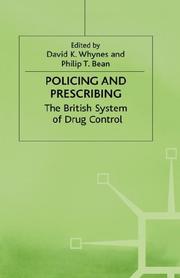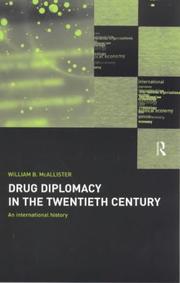| Listing 1 - 10 of 211 | << page >> |
Sort by
|
Book
Year: 2015 Publisher: Frontiers Media SA
Abstract | Keywords | Export | Availability | Bookmark
 Loading...
Loading...Choose an application
- Reference Manager
- EndNote
- RefWorks (Direct export to RefWorks)
Cannabis remains the most commonly used illicit substance world-wide, with international estimates indicating that 2.8%-4.5% of the global population use cannabis each year. This prevalence rate has not changed substantially in the past decade and there is no indication that it will do so in the next decade. In line with this, many prominent organisations and individuals have acknowledged that the “war on drugs” has failed and are now calling for a rethink on drug-related policy and legal frameworks. With a growing number of jurisdictions across the world heeding this call and introducing legislation to decriminalize or legalize cannabis use, it is essential that any changes to legal frameworks and public health policies are based on the best available scientific evidence.
Psychiatry. --- Cannabis --- Cannabinoids --- Affective disorders anxiety --- Addiction --- normalization --- marijuana --- legalization --- drug policy --- psychosis
Book
Year: 2015 Publisher: Frontiers Media SA
Abstract | Keywords | Export | Availability | Bookmark
 Loading...
Loading...Choose an application
- Reference Manager
- EndNote
- RefWorks (Direct export to RefWorks)
Cannabis remains the most commonly used illicit substance world-wide, with international estimates indicating that 2.8%-4.5% of the global population use cannabis each year. This prevalence rate has not changed substantially in the past decade and there is no indication that it will do so in the next decade. In line with this, many prominent organisations and individuals have acknowledged that the “war on drugs” has failed and are now calling for a rethink on drug-related policy and legal frameworks. With a growing number of jurisdictions across the world heeding this call and introducing legislation to decriminalize or legalize cannabis use, it is essential that any changes to legal frameworks and public health policies are based on the best available scientific evidence.
Psychiatry. --- Plant Sciences --- Agriculture --- Earth & Environmental Sciences --- Cannabis --- Cannabinoids --- Affective disorders anxiety --- Addiction --- normalization --- marijuana --- legalization --- drug policy --- psychosis --- Cannabis --- Cannabinoids --- Affective disorders anxiety --- Addiction --- normalization --- marijuana --- legalization --- drug policy --- psychosis
Book
Year: 2015 Publisher: Frontiers Media SA
Abstract | Keywords | Export | Availability | Bookmark
 Loading...
Loading...Choose an application
- Reference Manager
- EndNote
- RefWorks (Direct export to RefWorks)
Cannabis remains the most commonly used illicit substance world-wide, with international estimates indicating that 2.8%-4.5% of the global population use cannabis each year. This prevalence rate has not changed substantially in the past decade and there is no indication that it will do so in the next decade. In line with this, many prominent organisations and individuals have acknowledged that the “war on drugs” has failed and are now calling for a rethink on drug-related policy and legal frameworks. With a growing number of jurisdictions across the world heeding this call and introducing legislation to decriminalize or legalize cannabis use, it is essential that any changes to legal frameworks and public health policies are based on the best available scientific evidence.
Psychiatry. --- Plant Sciences --- Agriculture --- Earth & Environmental Sciences --- Cannabis --- Cannabinoids --- Affective disorders anxiety --- Addiction --- normalization --- marijuana --- legalization --- drug policy --- psychosis
Book
ISBN: 9176351602 9176351637 Year: 2021 Publisher: Stockholm Stockholm University Press
Abstract | Keywords | Export | Availability | Bookmark
 Loading...
Loading...Choose an application
- Reference Manager
- EndNote
- RefWorks (Direct export to RefWorks)
The drug policies of the Nordic countries have been relatively strict. Since this seems to contradict the internationally recognized liberal criminal policy in general, analyses have been devoted to try to understand this gap. Why doesn’t the “Scandinavian exceptionalism” apply to the drug policies? The new question in relation to drug policy is, however, if and how the Nordic countries will adapt to a situation when several countries all over the world are questioning ‘the war on drugs’ and orienting themselves in the direction of decriminalization and legalization. An analysis of a possible change in drug policies must be undertaken against the background of the existing policies. There are both similarities and differences between the five countries. A common feature is a stress on the demand side through both treatment and punishments directed against the user and abuser. Differences are shown in degrees of toughness in drug policies with Sweden strongest stressing a zero-tolerance stand and Denmark being the most liberal in the Nordic context. The strong welfare state ideology of all the countries is important for understanding the obstacles to a more liberal and permissive drug policy. The welfare state is an interventionist state. To not do anything about what is considered to be a problem both for the individual and the society is just not an option. In most of the countries the traditions from the temperance movements also have influenced the drug policies through the stepping-stone or gateway theory, not making a distinction between soft and hard drugs. At the same time, a number of facts and processes work in the direction of change. The drug policies of the countries have not delivered, including high numbers of drug-related deaths. The debate has opened up in just a short period of time. Many of the political youth parties demand decriminalisation of use of drugs and so have some public authorities. Human rights arguments are increasingly being put forward as a critique of police interventions. A tendency for politicians to meet the critique seems to be to separate the marginal abuser from the recreational user. The first one should be given treatment and care according to welfare state ideology. The second one, however, could be punished since the user in line with neo-liberal theory can choose and by the use contributes to the drug trade and even the killings in poor suburbs. The Nordic countries stand at a crossroads, but what new roads will be taken is far from clear.
Drug abuse and crime. --- Crime and drug abuse --- Drugs and crime --- Narcotics and crime --- Crime --- Penal policy --- Welfare state --- Nordic countries --- Zero tolerance --- Drug policy
Book
ISBN: 9282700208 Year: 1995 Publisher: Luxembourg Office for official publications of the European communities
Abstract | Keywords | Export | Availability | Bookmark
 Loading...
Loading...Choose an application
- Reference Manager
- EndNote
- RefWorks (Direct export to RefWorks)
Drugs --- Pharmaceutical policy --- Médicaments --- Law and legislation --- Droit --- Politique gouvernementale --- -Pharmaceutical policy --- -Drug policy --- Drugs and state --- Pharmacy --- Pharmacy and state --- State and drugs --- State and pharmacy --- Medical policy --- Medicaments --- Medications --- Medicine (Drugs) --- Medicines (Drugs) --- Pharmaceuticals --- Prescription drugs --- Bioactive compounds --- Medical supplies --- Pharmacopoeias --- Chemotherapy --- Materia medica --- Pharmacology --- -Government policy --- Government policy --- -Law and legislation --- -Drugs --- Médicaments --- Drug policy

Abstract | Keywords | Export | Availability | Bookmark
 Loading...
Loading...Choose an application
- Reference Manager
- EndNote
- RefWorks (Direct export to RefWorks)
Drug control --- Drug abuse --- -Pharmaceutical policy --- -Drug policy --- Drugs --- Drugs and state --- Pharmacy --- Pharmacy and state --- State and drugs --- State and pharmacy --- Medical policy --- Drug use --- Recreational drug use --- Substance abuse --- Great Britain --- -Prevention --- Government policy --- Pharmaceutical policy --- Prevention. --- -Great Britain --- Drug policy --- Great Britain&delete& --- Prevention
Book
ISBN: 3922498469 9783922498469 Volume: 41 Publisher: Freiburg in Brisgau : Max-Planck-Institut.
Abstract | Keywords | Export | Availability | Bookmark
 Loading...
Loading...Choose an application
- Reference Manager
- EndNote
- RefWorks (Direct export to RefWorks)
Narcotics, Control of --- Congresses --- Drug control --- 343.966 --- 343.966 Drugs --- Drugs --- Drug enforcement --- Drug law enforcement --- Drug policy --- Drug traffic --- Drug traffic control --- War on drugs --- Vice control --- Government policy --- Congresses. --- Drug control - Europe - Congresses.
Periodical
ISSN: 16833252 08735379 Year: 1996 Publisher: Lisbon : European Monitoring Centre for Drugs and Drug Addiction,
Abstract | Keywords | Export | Availability | Bookmark
 Loading...
Loading...Choose an application
- Reference Manager
- EndNote
- RefWorks (Direct export to RefWorks)
Drug control --- Drug enforcement --- Drug law enforcement --- Drug policy --- Drug traffic --- Drug traffic control --- Drugs --- Narcotics, Control of --- War on drugs --- Government policy --- Vice control --- Drug control. --- Europe --- EU countries --- Euroland --- Prevention --- European Union countries.

ISBN: 0415179904 0415179890 Year: 2000 Publisher: New York London Routledge
Abstract | Keywords | Export | Availability | Bookmark
 Loading...
Loading...Choose an application
- Reference Manager
- EndNote
- RefWorks (Direct export to RefWorks)
Drug abuse --- Drug control --- Prevention --- History --- International cooperation --- Drug enforcement --- Drug law enforcement --- Drug policy --- Drug traffic --- Drug traffic control --- Drugs --- Narcotics, Control of --- War on drugs --- Vice control --- Drug use --- Recreational drug use --- Substance abuse --- Government policy --- 20th century
Book
ISBN: 1108567088 1108475450 1108680178 1108622380 Year: 2019 Publisher: Cambridge : Cambridge University Press,
Abstract | Keywords | Export | Availability | Bookmark
 Loading...
Loading...Choose an application
- Reference Manager
- EndNote
- RefWorks (Direct export to RefWorks)
Iran has one of the world's highest rates of drug addiction: estimated to be between 2 and 7 percent of the entire population. This makes the questions that this book asks all the more salient: what is the place of illegal substances in the politics of modern Iran? How have drugs affected the formation of the Iranian state and its power dynamics? And how have governmental attempts at controlling and regulating illicit drugs affected drug consumption and addiction? By answering these questions, Maziyar Ghiabi suggests that the Islamic Republic of Iran's image as an inherently conservative state is not only misplaced and inaccurate, but in part a myth. In order to dispel this myth, he skilfully combines ethnographic narratives from drug users, vivid field observations from 'under the bridge', with archival material from the pre- and post-revolutionary era, statistics on drug arrests and interviews with public officials. This title is also available as Open Access on Cambridge Core.
Drug control --- Drug abuse --- Government policy --- Drug use --- Recreational drug use --- Substance abuse --- Drug enforcement --- Drug law enforcement --- Drug policy --- Drug traffic --- Drug traffic control --- Drugs --- Narcotics, Control of --- War on drugs --- Vice control --- drugs; Iran; politics
| Listing 1 - 10 of 211 | << page >> |
Sort by
|

 Search
Search Feedback
Feedback About UniCat
About UniCat  Help
Help News
News